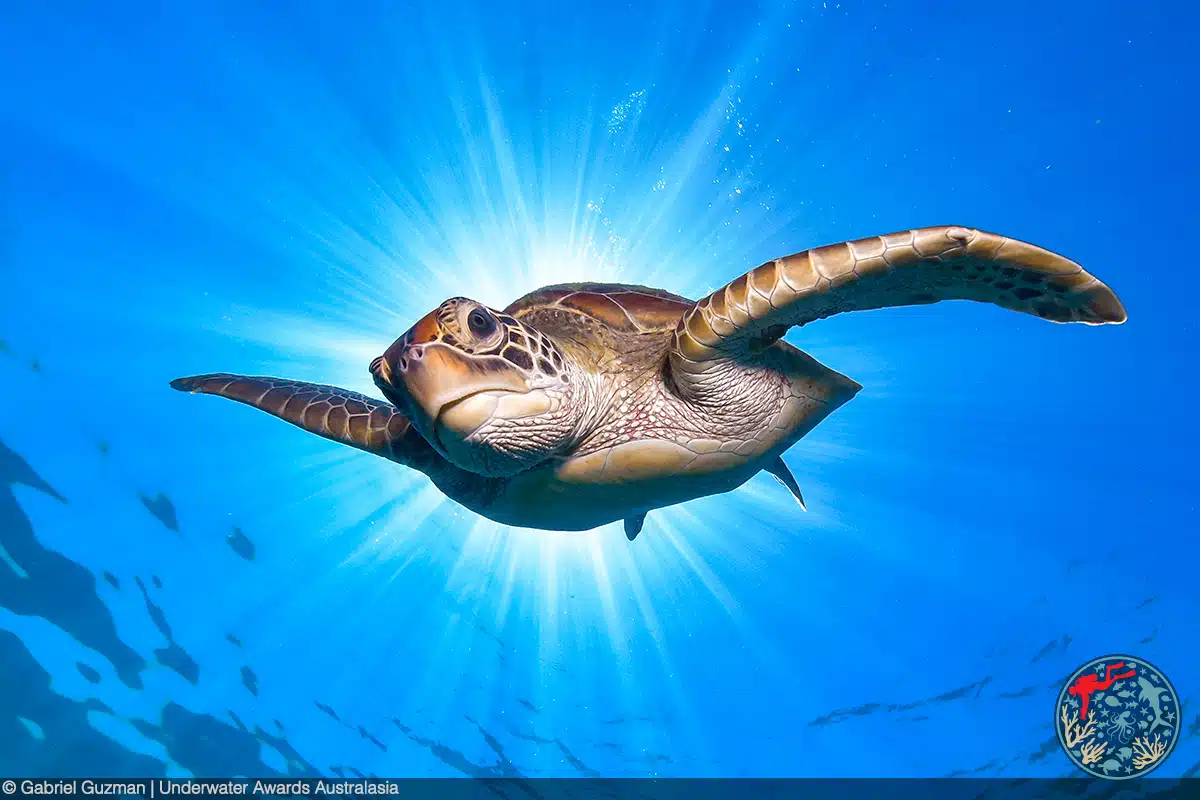
Green sea turtle from “The Sun and Sea Creatures” by Gabriel Guzman (Chile/Australia). 1st Place, Portfolio.
“Sunburst photography is a technique that utilizes the sun as a focal element to enhance the visual impact of underwater images. By positioning the subject in front of the sun, the resulting rays create a natural halo effect, adding depth and drama to the scene. This approach emphasizes the interaction between light and the marine environment, making the subject stand out in a striking manner. This portfolio includes six images: a stingray, a lionfish, a manta ray, a turtle, a humphead wrasse, and a titan triggerfish. These species were captured through a blend of planned shots and spontaneous opportunities.”
A photo competition celebrating the waters of Australia and New Zealand, as well as New Guinea and nearby islands, has just announced its winners. Photographer Gabriel Guzman was named “Best in Show” in the Underwater Awards Australasia 2024 for his exceptional underwater photography. Guzman uses a difficult technique called sunburst photography to capture aquatic life in a manner that is uniquely his own.
“This technique has captivated me for years, and I’ve dedicated considerable time to practicing,” he shares. “Achieving the perfect sunburst shot is not easy. It requires ideal conditions, including calm waters for the sun’s rays to penetrate clearly, full sunlight, and the subject positioned as close to the surface as possible. The creature must be in exactly the right spot, and one needs to have one’s camera and strobes set perfectly to capture the moment.
The process involves many failed attempts, as the alignment of all these factors is rare. This portfolio represents the best of those efforts—a collection of images where everything finally came together.”
Aside from Guzman, who also won the Portfolio category, seven other category winners were named. Among these winners is Emma Turner who topped the Environmental category for her fascinating blackwater photo of a nautilus riding a yogurt lid. The eye-opening photo is not only visually striking, but also a sad commentary on how commonplace scenes of this nature have become.
Scroll down to see more of the exceptional winners who competed for prizes worth more than AU$50,000 (US$35,000), including dive trips and underwater photo and video gear.
The inaugural Underwater Awards Australasia invited photographers to share their most compelling images from the region.
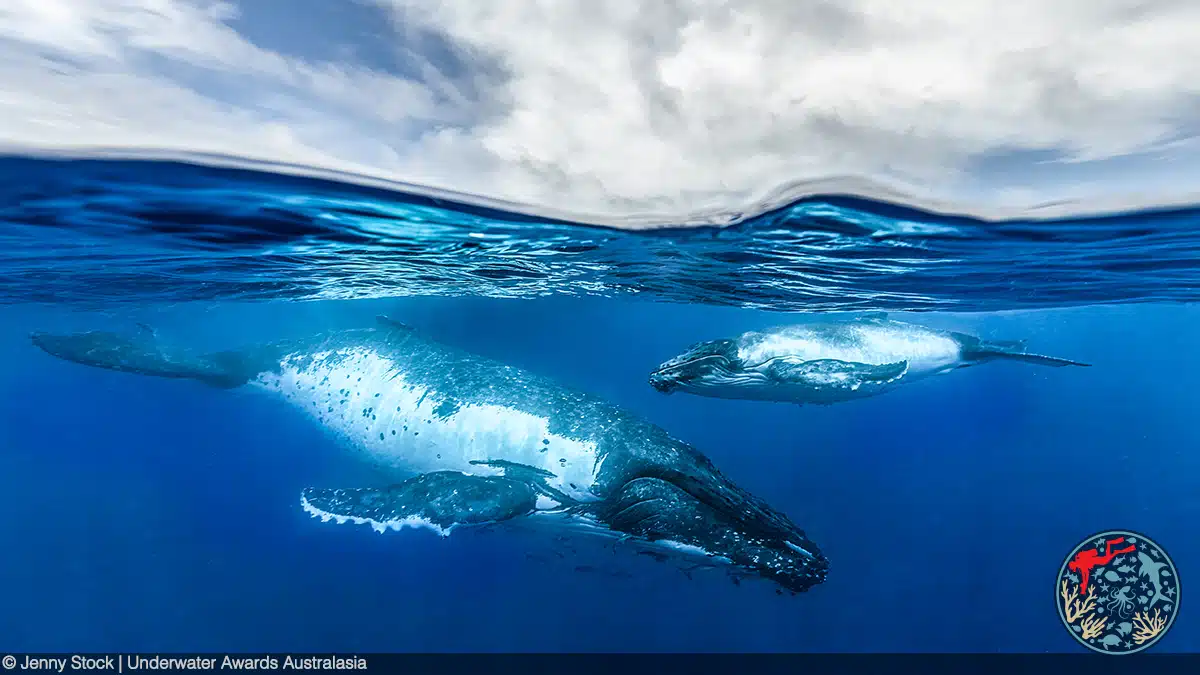
“Calm Tongan Nursery” by Jenny Stock (UK). 1st Place, Over-Under.
“Here a mother humpback whale and her new young calf are resting just below the surface in the calm, warm waters of Vava’u. Heavily pregnant female humpbacks arrive every year in July. After giving birth, they stay in this nursery setting until the calves are big enough to make their first trip to Antarctica. When taking split images, it is often wise to use a snorkel rather than dive on scuba, as you create fewer bubbles on the surface, which can be distracting in the image.”
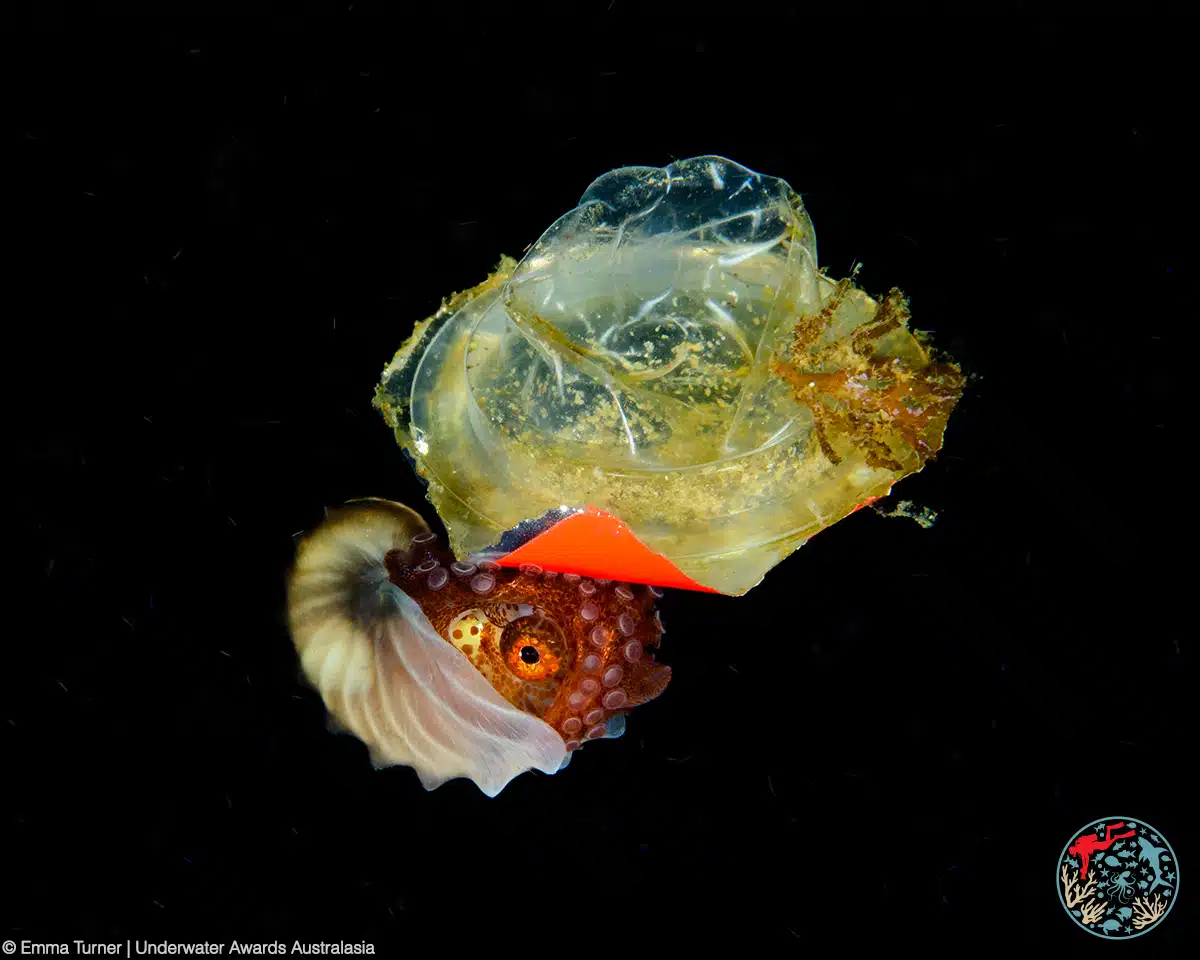
“Hitchhiker” by Emma Turner (Australia). 1st Place, Environmental.
“Blackwater diving—drifting untethered over deep water in the dark of night with no visual reference other than a downline of lights hoping to glimpse the “otherworldly”—is my happy place. This female argonaut, actually an octopus with an egg case “shell”, emerged out of the blackness and zoomed past me. This was my opportunity. Was it riding a jellyfish like I’d hoped? As my eyes and camera focus, I wondered what it was actually riding. Metallic? Plastic? Both? A condom wrapper? Oh my gosh, a yogurt lid! How sad for us both. Was this argonaut surfing humans’ litter right back out of its open ocean home or was it becoming so “normal” to see pollution that it mistook as organic?”
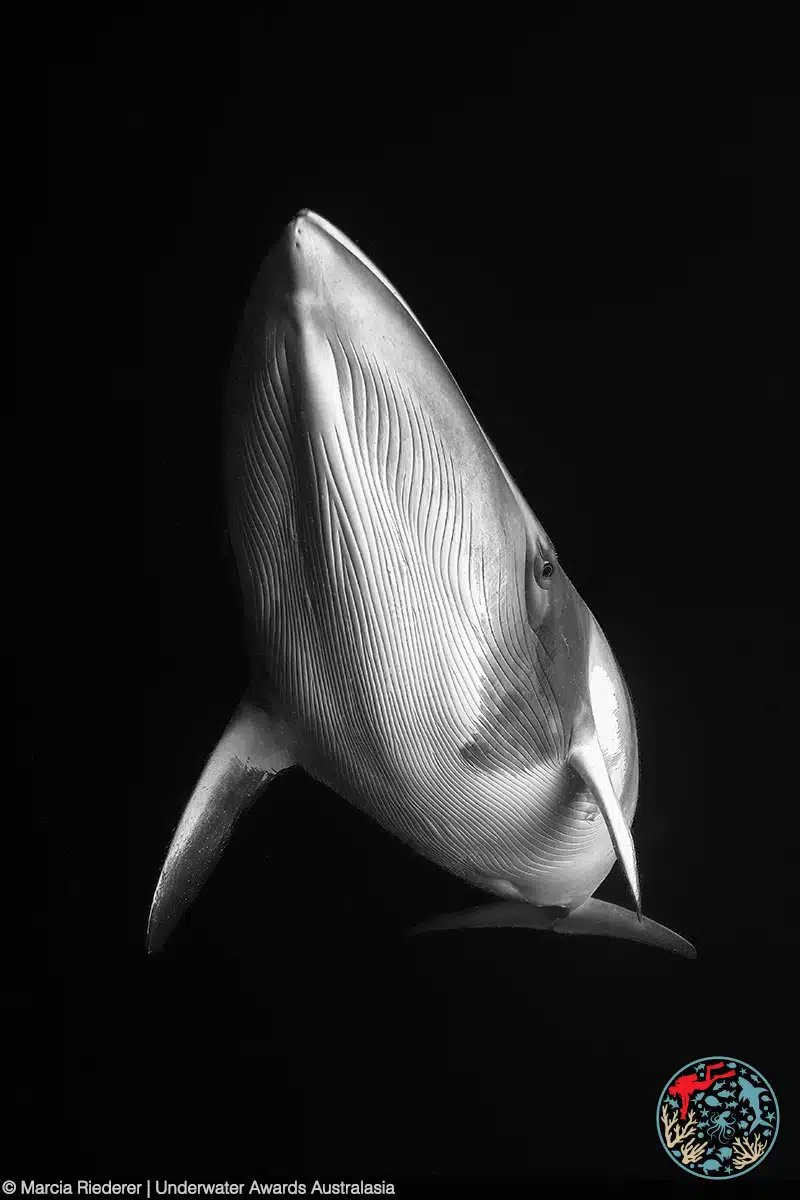
Dwarf minke whale from “The Minke Whale” by Marcia Riederer (Australia). 2nd Place, Portfolio.
“These images are a selection of my favorite moments during my eye-to-eye encounters with curious dwarf minke whales. I was fortunate to have four days of stunning weather and outstanding sea conditions on a liveaboard dedicated to interactions with minke whales on the Ribbon Reefs, Great Barrier Reef. Most of the days were spent hanging on the mermaid line, while multiple whales took turns swimming around us. Many times, they would come very close and look into my eyes. Little is known about these dwarf minke whales other than that they visit the northern Great Barrier Reef each winter. The behavior of minkes seeking out human interaction is still a subject of ongoing scientific study and research. While the exact reasons for their behavior are not fully understood, it is essential that responsible and respectful guidelines are always followed. By doing so, we allow the whales to have full control of the interactions, making each of those opportunities a privilege. I shared the trips with researchers from the Minke Whale Project, who they were collecting information for studying and monitoring these whales in order to better understand their population and conservation needs. It is important to continue research and conservation measures to ensure the long-term wellbeing of dwarf minke whales and their habitats.”
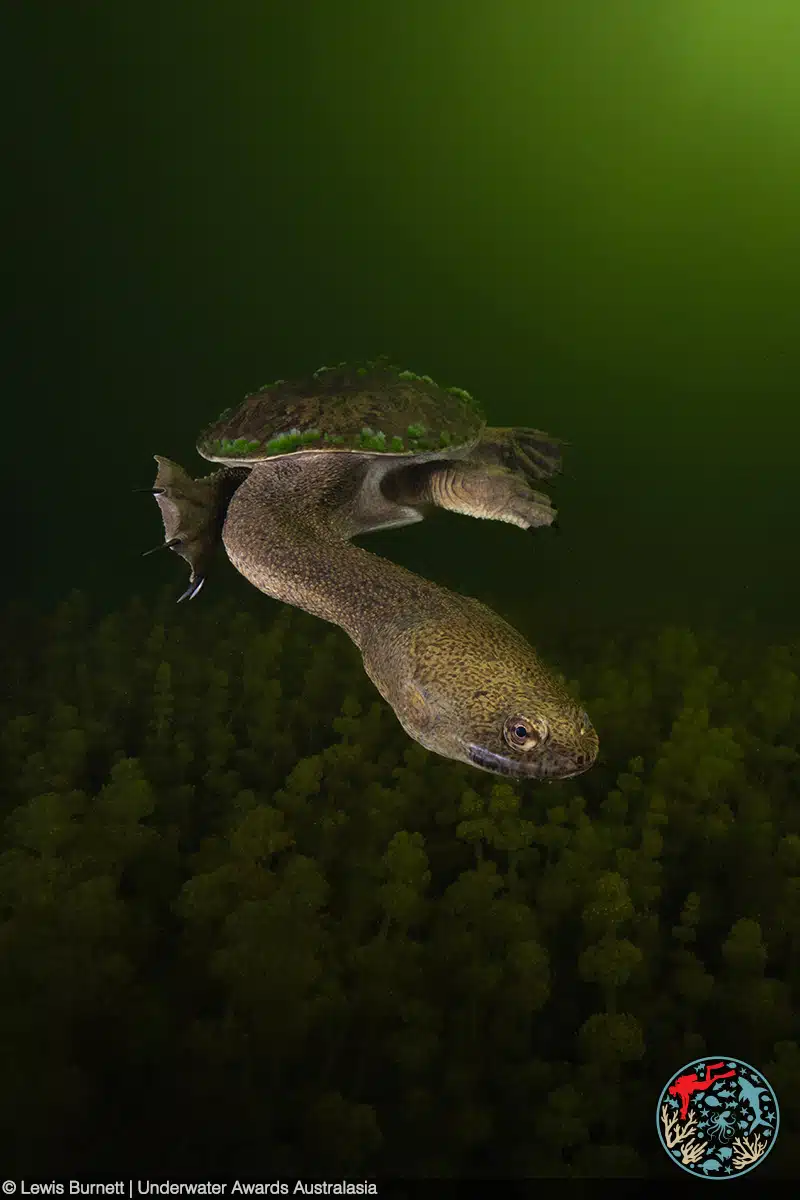
“Oblong” by Lewis Burnett (Australia). 1st Place, Australian.
“Photographing the bizarre and wonderful snake-necked turtle underwater had always been on my South-West diving wishlist. These fascinating reptiles are found in the freshwater bodies that scatter the region and are most commonly seen on land in the breeding season while they are searching for a mate. I found this particular individual on my first ever freshwater dive in the region and couldn’t have been happier to have such an obliging subject to photograph.”
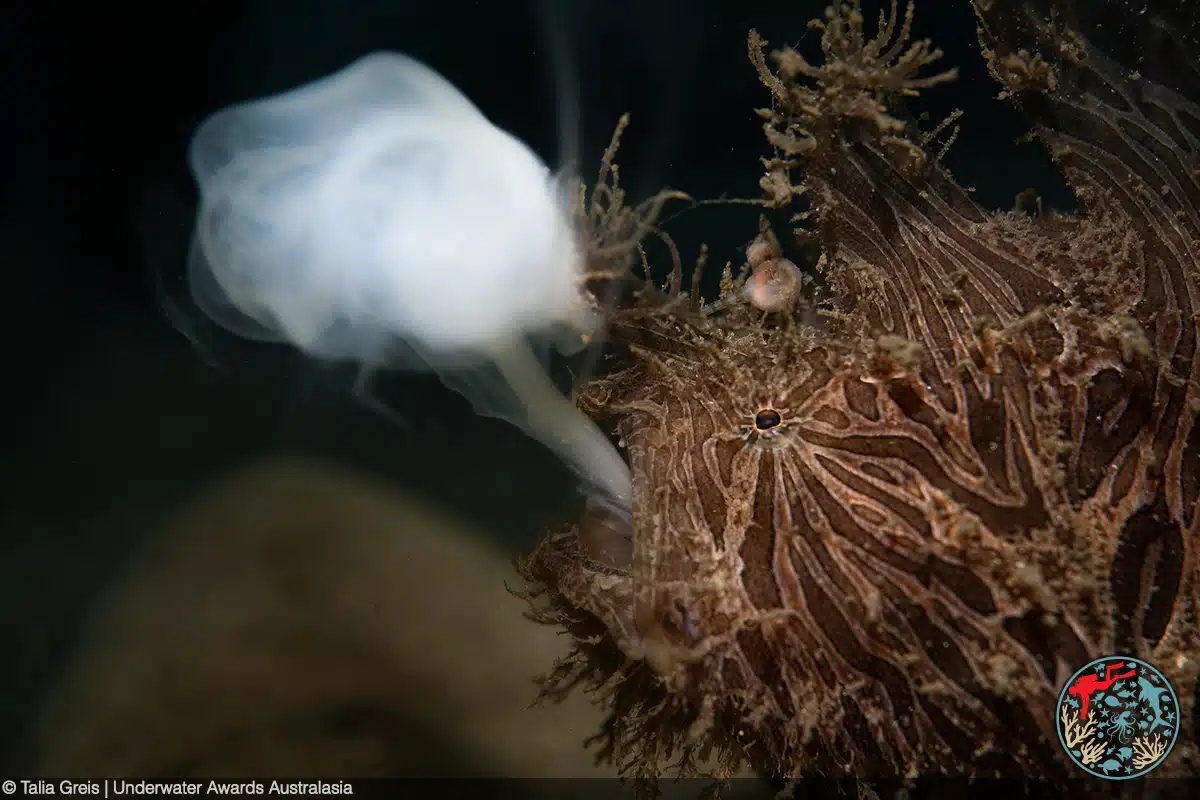
“Puff” by Talia Greis (Australia). 1st Place, Sydney.
“This unusual, undocumented behavior cannot be explained by even the most skilled of scientists, specializing in frogfish/anglerfish behavior. I was experimenting with wide aperture photography at a local dive site when this striated anglerfish (clearly having devoured a huge meal) regurgitated a smoke-like substance. Never having witnessed such an occurrence, I sat and observed the behavior for over an hour. Experts can only speculate that the angler had cannibalised an egg sac (intentionally or non-intentionally). This likely would have led to swelling of the stomach, causing the individual to cough up chunks of it at a time. Nature at its best.”
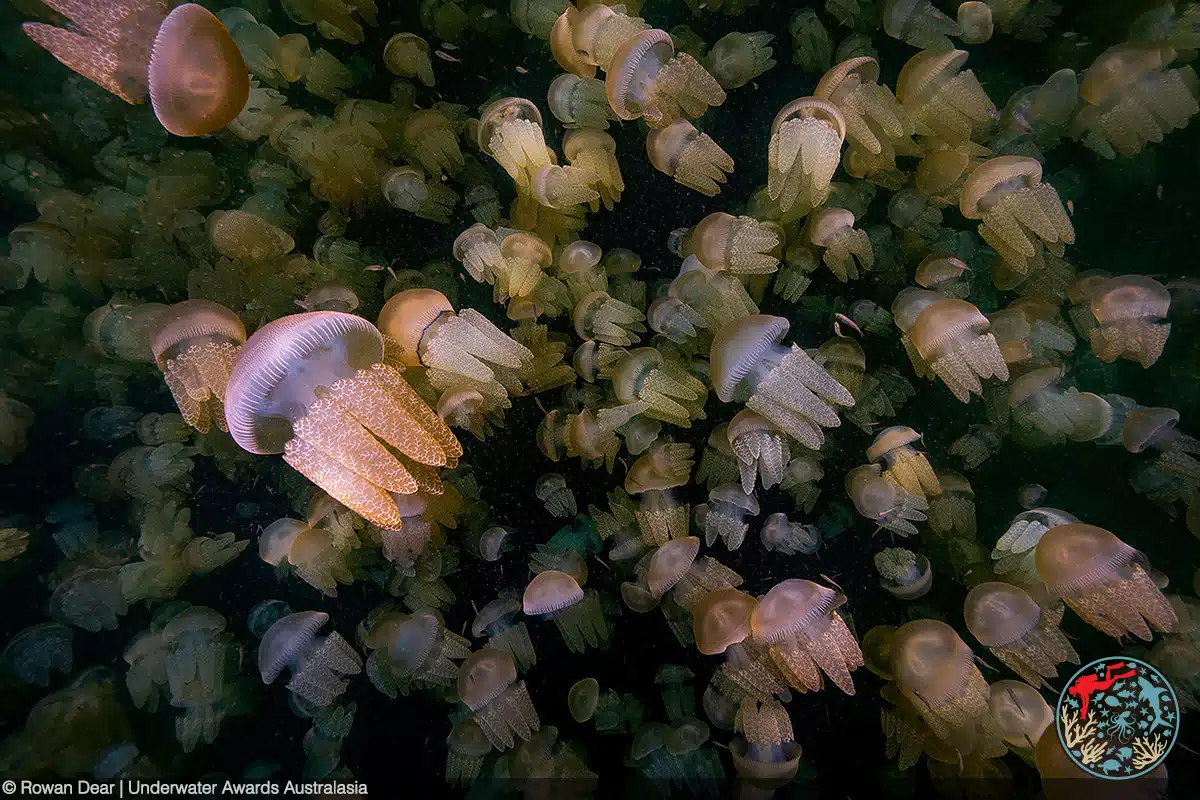
“Depth Perception” by Rowan Dear (UK). 2nd Place, Sydney.
“These jellyfish had been seen in their hundreds each of the last three years gathering in the bay at one of Sydney’s popular beaches. This particular year, there were more than I had ever seen, with some sections being several meters deep and densely populated. Swimming into the smack and shooting downwards into the deepest concentration of the jellies, I was hoping to create this otherworldly image with plenty of depth, showing just how many there were of them.”
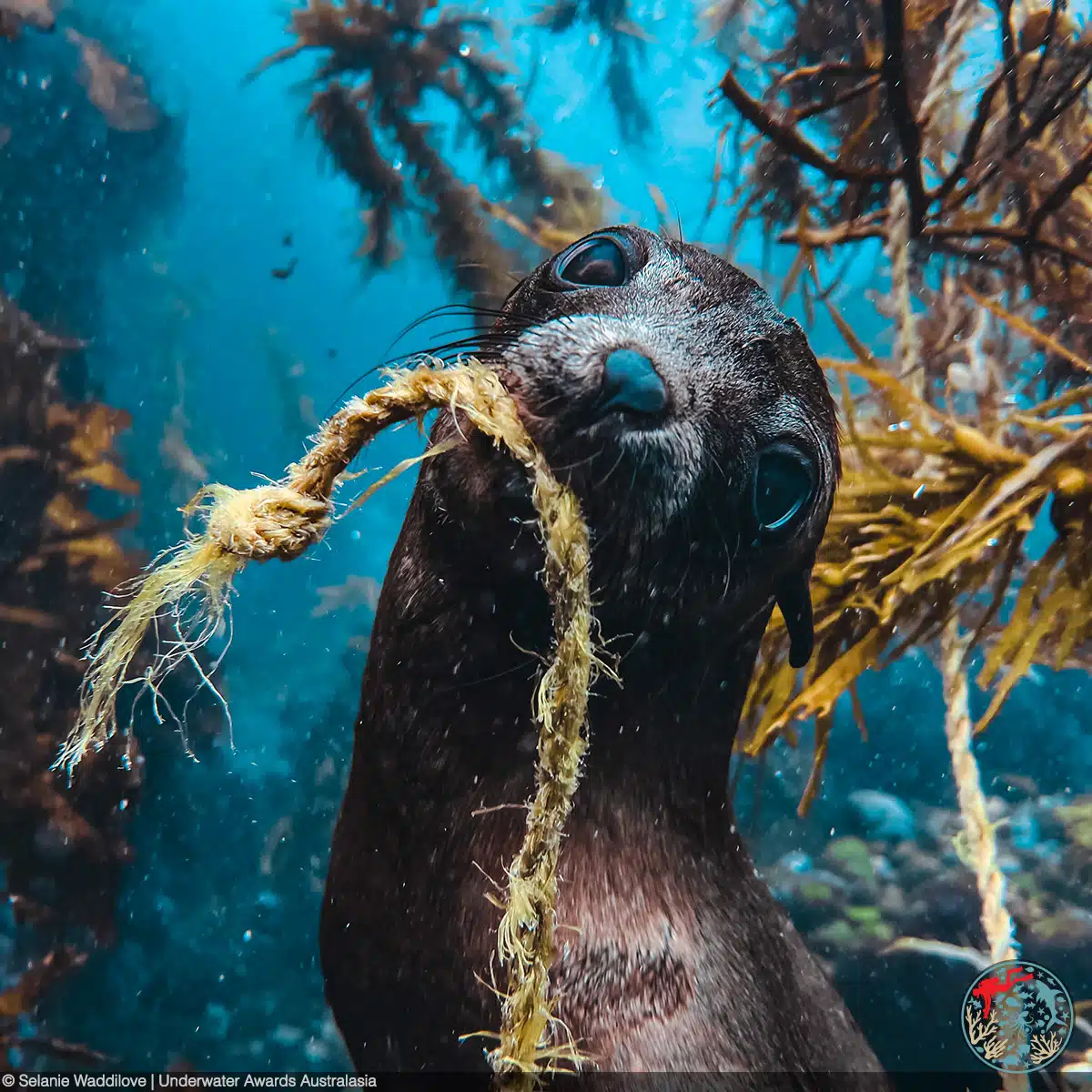
“Can I Help?” by Selanie Waddilove (Australia). 1st Place, Smartphone.
“Sometimes a photo is asking to be taken… The playful pose of this pup in contrast with the abandoned rope was both confronting and beautiful. Often the New Zealand fur seal pups at Baranguba will play tug of war and chase with drifting seaweed, letting it go to dive and spin around you and then picking it back up again before another pup can steal it. This early April morning, instead of seaweed, the pups were playing with some rope and other plastic debris that had been washed in by the swell and winds of the previous week. I snapped a few photos to capture their fun and gently tugged on the end of the rope, hoping to distract them with a game so I could eventually collect it. As the seals played, I gradually rolled it up in my hand and hid it in my wetsuit to be disposed of properly when we returned to shore.”
Gabriel Guzman was named “Best in Show” for his strong portfolio of sunburst photos.

“Lionfish in Sunburst” by Gabriel Guzman. 2nd Place, Australian.
“I spotted a lionfish swimming near the surface. The conditions were ideal for capturing something truly special, so I knew I had to approach carefully. Holding my breath to avoid creating any bubbles that might disturb the pristine surface, I slowly maneuvered beneath the lionfish. As I positioned myself, I could see the sun’s rays piercing the water, illuminating the scene like a spotlight on a stage. With the lionfish framed perfectly against the sunburst, I began capturing the moment. The combination of the serene surface, the radiant sunbeams, and the majestic lionfish created one of my favorite sunburst photos I’ve ever taken.”
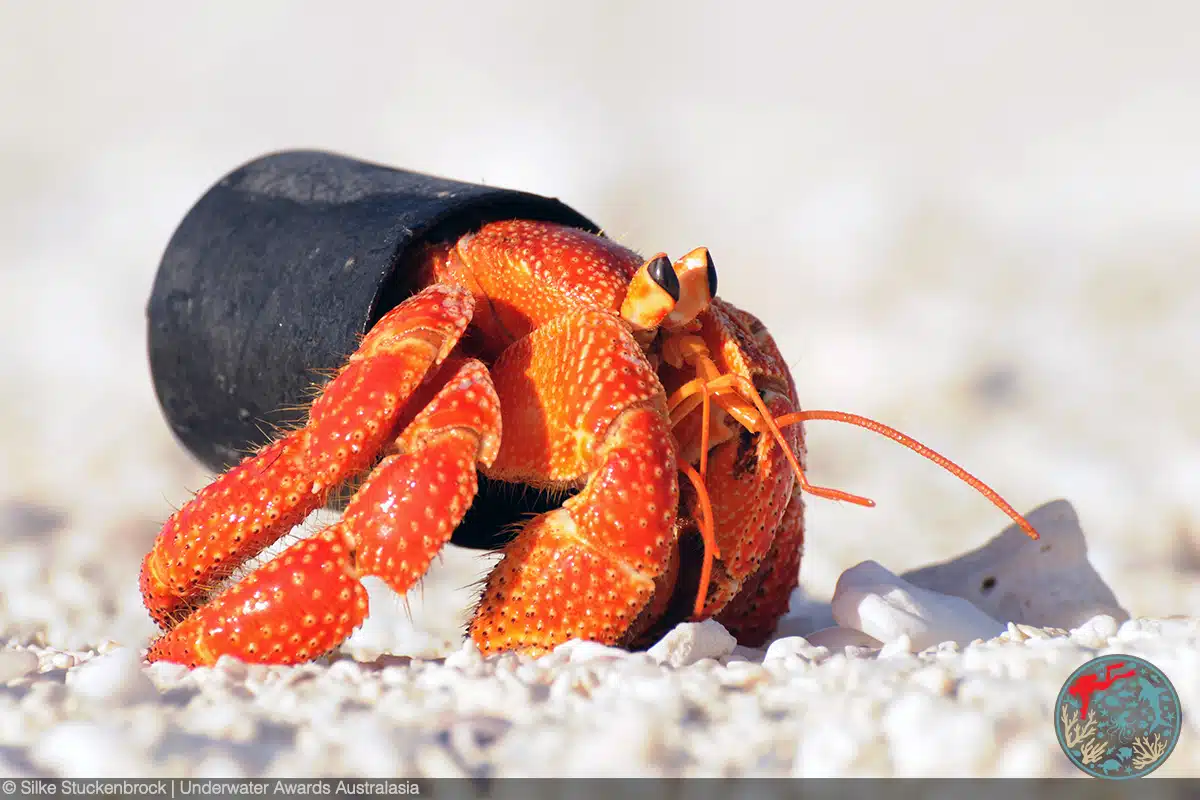
“Fashion Victim” by Silke Stuckenbrock. 3rd Place, Environmental.
“After sailing for days to a remote coral quay at the edge of Australia’s Great Barrier Reef, a hermit crab appears on a seemingly pristine beach. Instead of a shell, she is carrying a large plastic lid. As hermit crabs grow, they look for bigger shells. Larger shells need to be renovated to be lighter, and this lid is both large and light. The crab seems content with her choice, though she would be much more easily extracted from her plastic home by a predator. Renovated shells often get passed around for generations, which highlights the importance of leaving shells on the beach and taking away plastic trash instead. With the evening light low, I, too, found a low angle, equipped with only my old but trusty DSLR, long lens, and my hat as a lens support. This shot came together beautifully, the hermit crab remaining undisturbed, and the shallow depth of field allowing the subject to be the focus of the image.”

Ribboned sweetlips from “Blue Voices: Capturing Beauty and Driving Conservation Through the Lens” by Paula Vianna (Brazil). 3rd Place, Portfolio.
“This portfolio captures the extraordinary diversity of marine life found in the waters of Australia, Indonesia, and Papua New Guinea. Each image was carefully selected to highlight the beauty of the ocean’s inhabitants and to foster a sense of connection and responsibility towards their preservation. The first image showcases a vibrant school of yellow snappers, their striking patterns a testament to the rich biodiversity of coral reefs. These images remind us of the intricate relationships within marine ecosystems and the urgent need to protect them. The portfolio aims not only to document the beauty of marine life but also to inspire a deeper appreciation and commitment to preserving these vital, yet vulnerable, environments.”
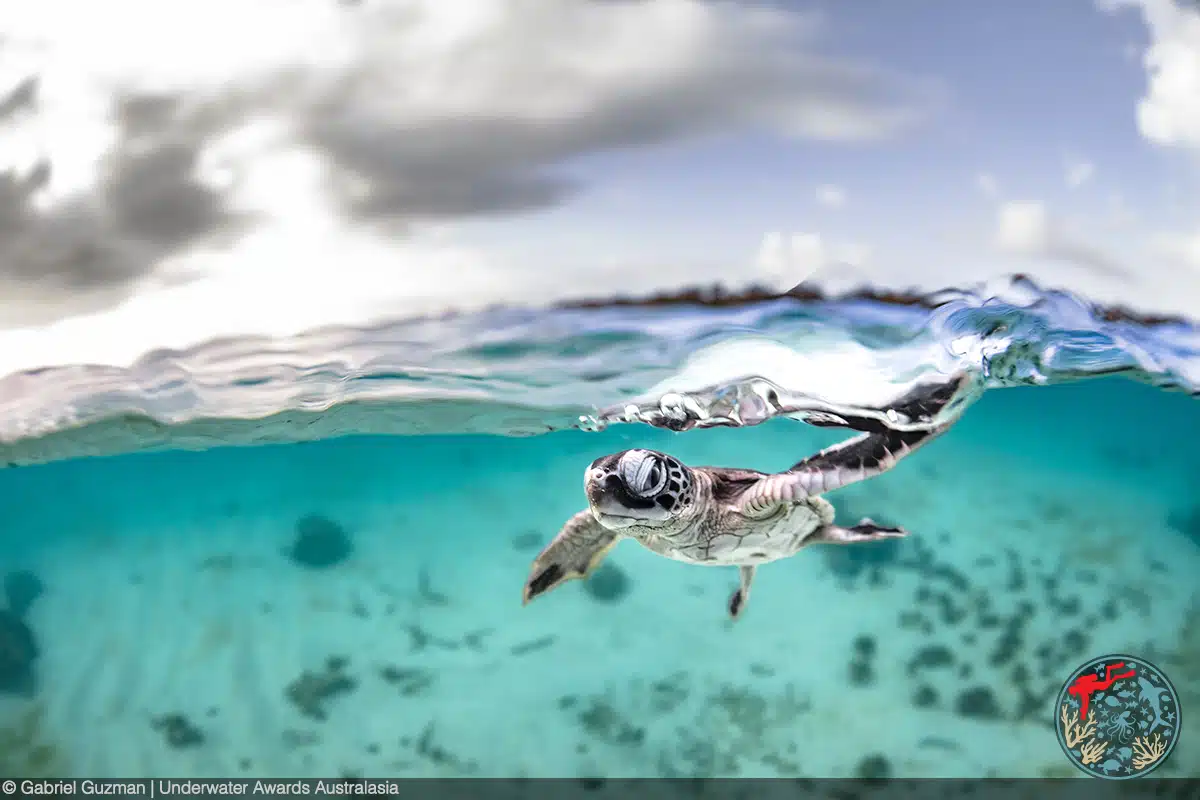
“Baby Turtle” by Gabriel Guzman (Chile/Australia). 2nd Place, Over-Under.
“Captured at Heron Island, a vital nesting site for sea turtles, this split shot reveals the moment of a baby turtle’s first swim after hatching. The image gracefully transitions between the shallow waters and the expansive horizon, showcasing the turtle’s journey from its birthplace to the vast ocean beyond. In capturing this moment, I took care to avoid using strobes or artificial light, respecting the delicate nature of these newborns. After taking a few photos, I allowed the hatchling to continue its journey without additional stress. This photograph is a tribute to the resilience and beauty of new life, highlighting both the significance of Heron Island and the responsibility of preserving its natural wonders.”
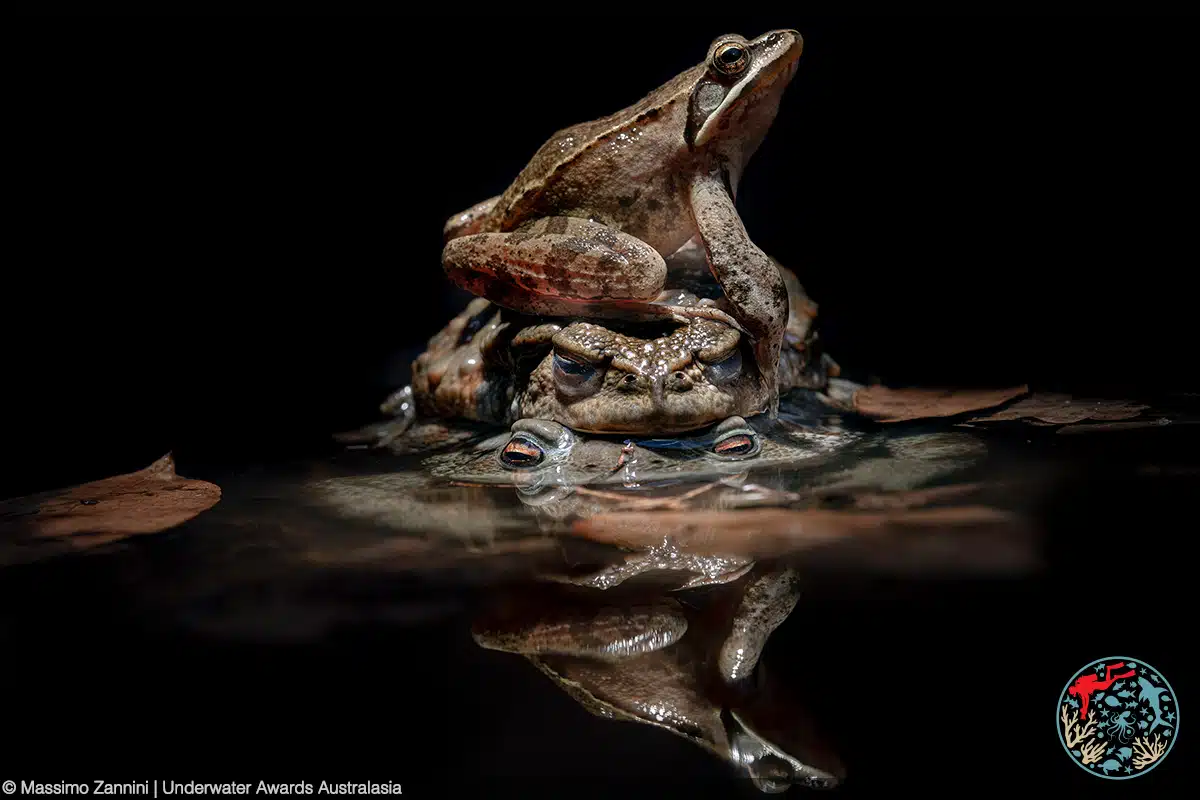
“Amphibian Tree” by Massimo Zannini (Italy). 2nd Place, International Waters.
“In springtime in the mountains of northern Italy, toads mate in small pools of water like many other amphibians. I was taking some photos of this mating behavior when for a few seconds a frog jumps on their backs, probably mistaking them for a rock. Surprised and amused, I had just enough time to take three shots before the frog was ejected by the male toad on top of the female.”
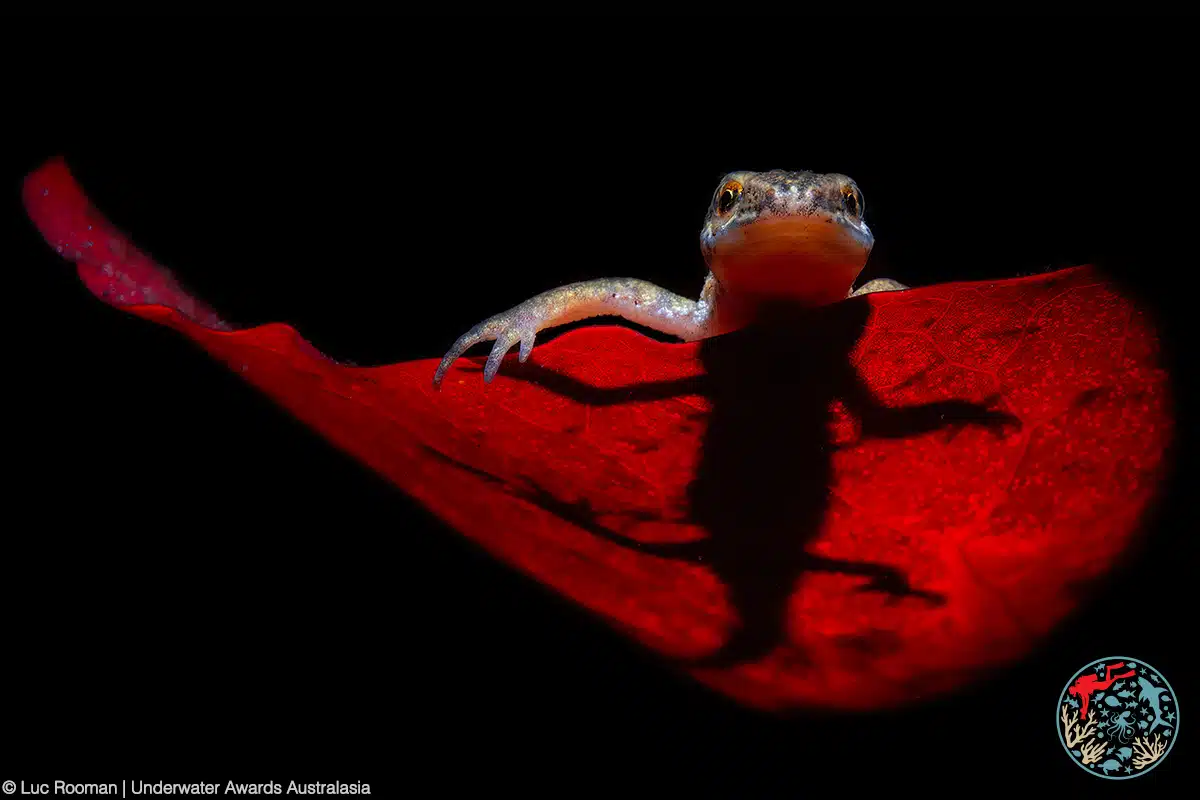
“Salamander” by Luc Rooman (Belgium). 1st Place, International Waters.
“Every year, I dive into one of my beloved freshwater lakes, namely De Melle near Antwerp, to photograph the alpine newts among the water lilies. In July this year, I went looking again. After trying to photograph several specimens, I discovered one perched on a water lily, the body of the salamander producing an interesting silhouette through the leaf. After taking a series of shots, I left the creature alone and carefully moved on.”

“The Grumpy Turtle” by Christopher Fletcher (Australia). 3rd Place, Smartphone.
“This photo was taken on a dive in Moalboal, Philippines. There were turtles everywhere! However, this one caught my eye as he was perched on a coral outcrop catching up on some sleep. When I turned on the dive lights, he raised his head as if to say, “How dare you interrupt my sleep?” The look was priceless. Once I captured the shot and turned off the lights, his head drooped as he went back to dreaming whatever turtles do….”
